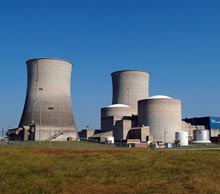Obama Goes Nuclear
President Obama’s proposed 2011 budget could provide a significant boost to the U.S. nuclear power industry, which has been stalled for decades. If approved by Congress, the budget would provide $36 billion in loan guarantees for nuclear power plants, opening the way for around seven new nuclear power plants, depending on the final cost of each. The new guarantees are in addition to $18.5 billion in guarantees provided for in a 2005 energy bill.

The increased support for nuclear power marks a change for the Obama administration, which has opposed similar increases in the past. Some policy experts say it is part of a strategy to win Republican votes for a comprehensive climate and energy bill.
The loan guarantees are needed because investors are reluctant to put up money for nuclear power plants, which raises the cost of financing. Investors are worried about uncertainties in the cost of the plants, especially since it’s been so long since any new ones have been built. They’re also concerned that, historically, political support for nuclear power plants has been unstable, with regulatory backing disappearing in less time than it would take to build a new plant.
By guaranteeing loans, the government can bring down financing costs. The fact that the support for nuclear is now bipartisan–coming from both the president and from Republicans in Congress–also suggests that it will remain stable beyond the current administration, says Charles Forsberg, the executive director of the MIT Nuclear Fuel Cycle Project. As a result, he says, more utilities could be willing to undertake the construction of nuclear power plants.
According to one recent analysis, the cost of building nuclear power plants has approximately doubled in the last seven years (due to things such as increasing materials costs). As it stands, this means that the cost of electricity from new plants would be around 8.4 cents per kilowatt hour, compared to about 6 cents per kilowatt hour for conventional fossil fuel plants. But cutting the cost of financing could make nuclear competitive with fossil fuels, says Andrew Kadak, a professor of nuclear engineering at MIT.
Still, the loan guarantees alone might not be enough to restart the nuclear industry. One urgent need is for more trained workers, says Mujid Kazimi, a professor of mechanical engineering at MIT. It may be possible to build one or two power plants at a time, but he says to build more than that simultaneously would require increasing funding for training programs by about five times, to $10 million.
Kazimi also emphasizes that the new loan guarantees must be managed properly. The process of issuing them should be faster, for one thing: After five years, none of the $18.5 billion in guarantees included in the 2005 bill have been issued. Also, some of the terms make it difficult for companies to get financing. For example, the 2005 guarantees did not cover the entire cost of the plant–only 80 percent. Not only was the remaining 20 percent not guaranteed; it was more likely to be unrecoverable if the loan defaulted. That’s because the government insisted that it be paid back before any private creditors.
Even with the new loan guarantees, some utilities plan to wait until a few nuclear power plants have been built in the U.S. before going ahead with their own. Once company, Exelon, says it’s still concerned about whether nuclear plants will prove profitable, and emphasizes the need to find a permanent way to store nuclear waste. The Obama administration has scuttled the much debated Yucca Mountain waste repository, and announced a blue ribbon panel last week to investigate alternative ways to address waste. But the waste problem does not need to be solved immediately, Forsberg says, because current dry cask storage will remain a practical option for a century.
The new loan guarantees may be a risky political move for Obama, warns Dan Weiss, a senior fellow at the Center for American Progress in Washington, DC. He notes that while offering the guarantees has met with approval from some Republicans, it has not yet persuaded them to support the comprehensive energy and climate change legislation Obama hopes to pass.
Keep Reading
Most Popular
Large language models can do jaw-dropping things. But nobody knows exactly why.
And that's a problem. Figuring it out is one of the biggest scientific puzzles of our time and a crucial step towards controlling more powerful future models.
The problem with plug-in hybrids? Their drivers.
Plug-in hybrids are often sold as a transition to EVs, but new data from Europe shows we’re still underestimating the emissions they produce.
Google DeepMind’s new generative model makes Super Mario–like games from scratch
Genie learns how to control games by watching hours and hours of video. It could help train next-gen robots too.
How scientists traced a mysterious covid case back to six toilets
When wastewater surveillance turns into a hunt for a single infected individual, the ethics get tricky.
Stay connected
Get the latest updates from
MIT Technology Review
Discover special offers, top stories, upcoming events, and more.